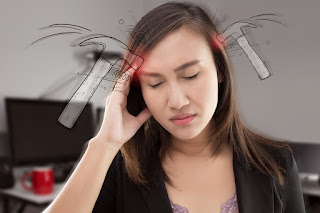Anyone who’s experienced the splitting pain of a bad headache or migraine attack knows how difficult it can be to work, drive, or even carry on a conversation while your head is pounding.
But when a headache strikes, you can do more than just crawl into bed and wait for it to go away. There are effective headache treatments available and ways to find quick relief.
Common Causes of Headaches
The best way to get rid of a headache quickly may depend on what’s causing it and what type of headache it is. A primary headache is caused by overactivity or problems with the pain-sensitive structures in your head, according to the Mayo Clinic. Common types of primary headaches include migraine attacks and tension headaches.
A less common type of primary headache is a cluster headache, which comes on suddenly, almost always affects only one side of the head, and is accompanied by a runny nose and tearing eye on the same side of the head as the headache. The pain of a cluster headache is severe and lasts from 15 minutes to 3 hours, when untreated. For most people, cluster headaches occur in a series, or in “clusters,” lasting weeks or months, separated by remission periods of months or years.
A secondary headache is a symptom of a disease that can trigger pain-sensitive nerves in the head. There are many conditions that can cause a secondary headache, from a sinus infection to a brain aneurysm to hangovers to COVID-19, the illness caused by the novel coronavirus SARS-CoV-2.
While a hangover or a headache caused by a sinus infection or by COVID-19 may respond to the same pain-relieving treatments as a tension headache, a brain aneurysm, or other severe headaches associated with neurologic changes such as weakness or loss of consciousness, for example, are medical emergencies that you shouldn’t attempt to treat on your own.
If you experience these symptoms, or you have the classic “worst headache you’ve ever had” of a brain aneurysm, or you have such symptoms as dilated pupils, blurred or double vision, pain above and behind an eye, weakness, numbness, or difficulty speaking, seek medical help immediately.
Over-the-Counter Medication for Tension Headache Relief
Just about any over-the-counter (OTC) pain reliever can offer relief for nonmigraine headaches, also known as tension headaches, says Jack M. Rozental, MD, PhD, associate professor of neurology and a headache specialist at Northwestern University’s Feinberg School of Medicine in Chicago.
Medication that contains only one drug, like Tylenol (acetaminophen), Advil (ibuprofen), Aleve (naproxen), or aspirin are effective headache treatments, he says, as are those that include a combination of aspirin, acetaminophen, and caffeine.
Prescription Painkillers for Frequent Tension Headaches
For those people who have frequent or recurring tension headaches, doctors sometimes recommend prescription-strength doses of nonsteroidal anti-inflammatory drugs (NSAIDs), such as ibuprofen or naproxen.
Indocin (indomethacin), an NSAID that is available only by prescription, is “usually used for arthritis, but can also be very useful as a headache treatment,” Dr. Rozental says. “Indomethacin‘s downside is that it is among the drugs most likely to cause gastric irritation as a side effect,” including stomach ulcers and bleeding. It can also harm kidney function if taken at high doses or chronically.
Prescription Drugs for Quick Migraine Relief
Headaches caused by migraine frequently occur along with other symptoms, such as nausea, vomiting, or sensitivity to light and sound, according to the U.S. National Library of Medicine. Many people experience a migraine attack as a throbbing pain on one side of the head. Treating migraine symptoms right away can shorten the attack.
The types of medications that can alleviate symptoms once a migraine attack has started are known as acute, abortive, or rescue medications. These include OTC pain relievers such as aspirin and ibuprofen, prescription medications called triptans, and a new class of drugs called CGRP receptor antagonists.
Triptans Triptans are selective-serotonin receptor agonists, which means that they are believed to stimulate serotonin, a neurotransmitter found in the brain, to reduce inflammation and constrict blood vessels, which in turn stops the headache or migraine attack, according to the National Headache Foundation.
There are currently seven triptan drugs available in the United States: Axert (almotriptan), Relpax (eletriptan), Frova (frovatriptan), Amerge (naratriptan), Maxalt (rizatriptan), Imitrex (sumatriptan), and Zomig (zolmitriptan). All are available in pill form; two, Imitrex and Zomig, come as a nasal spray; and one, Imitrex (and other brands of sumatriptan) are sold in an injectable form.




